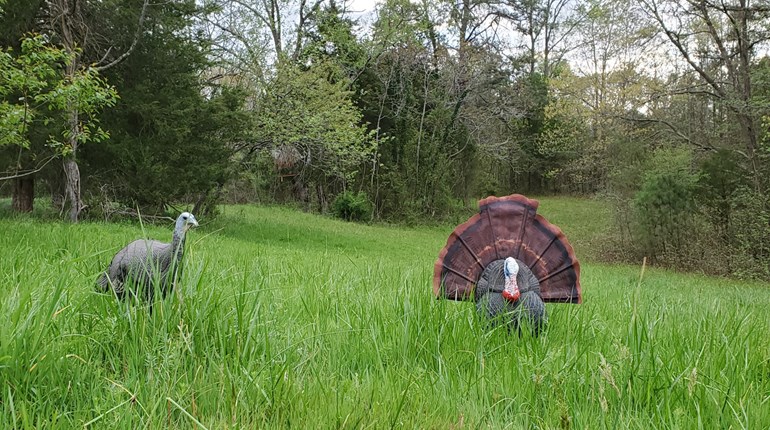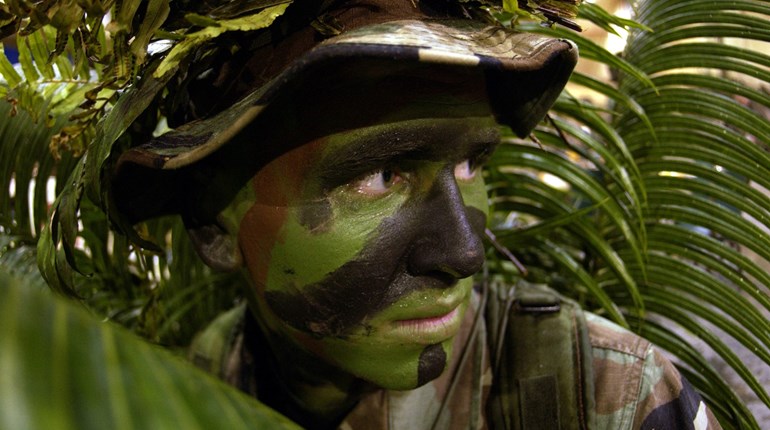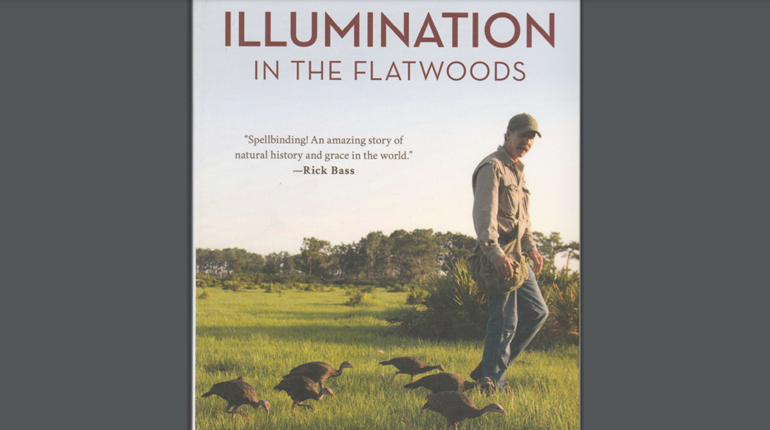
The sycamores surprise me. Their unmistakable white-blotched trunks are the first things to become visible as the early rays of morning fill the narrow creek bottom. Shifting my eyes across the blind window, I realize I am surrounded by these broadleaved giants. This is not what I expected to find in dry, dusty, scrubby Sonora. The creek bottom is, in fact, an oasis tucked among steep-sided hills covered in cactus and thorny brush. More light reveals it is green down here, while up top it is mostly shades of tan. For Gould’s turkeys and the three of us in the blind, this tiny drainage may as well be a desert paradise.
The birds started an hour earlier, hailing the full moon with long strings of gobbles. That is why outfitter Ted Jaycox insisted we leave the bunkhouse no later than 4 a.m. He and Mossberg’s Linda Powell and I slipped down the sandy two-track, our footfalls covered by the gurgling of the creek beside us. There was little need to worry about making noise, as what the water didn’t disguise the gobblers drowned with their relentless talk from the roost. Each sequence was a choppy chain of three to five and sometimes even more short gobbles one right after the other. My heart danced to the birds’ rhythm as we made our way to the blind.
Now, though, the gobblers are quiet. I’m more than 2,000 miles from home, but this situation is all too familiar. Birds hammer from their perches in the sycamores (trees that are not at all unexpected in the eastern United States) but then shut down when they hit the ground. As is always the case, disappointment grows with each minute of silence. This could be a long morning. We settle in for the wait.
It’s our best bet. Like any good turkey outfitter or hunter should, Ted has scouted these birds. He knows their ways. With all due respect to him, deciphering their pattern is not difficult. They leave plenty of clues: dozens of gobbles at first light, tracks and parallel lines in the sand where their wings drag on the ranch road leading to the creek.
Water is the biggest piece of the puzzle. Turkeys need it, and by the looks of things there’s only one place to get it here. At some point today, a gobbler will come to this creek for a drink. The road provides a perfect clearing for a bird to fan his feathers and be seen by hens, and when all that courting makes him thirsty, wetting his beak is but a short stroll away. It is the equivalent of teenagers flocking to an ice-cream stand on the boardwalk.
Our strategy is as simple as it is effective: Sit down someplace between a gobbler and where he’s heading, and wait. I know in this case, however, it’s not that cut and dried. The creek runs for miles with long stretches of the road nearby. These birds have many ways to get to the water, which becomes apparent when a lone longbeard appears 150 yards upstream of the blind. Instead of taking the easy road, he decides to pick his way down a rocky bank. Typical “stupid” turkey behavior, at least in the eyes of a “smart” hunter.
I watch through my bino as the bird dips his head to the water, his beard silhouetted against the light gray stones behind it. Gould’s gobblers are not known for heavy beards, but this one has a fine brush comparable to an Eastern bird’s. My first look at a live Gould’s causes me to recall the first time I heard of the subspecies. I was a kid standing quietly in the living room of one of my grandfather’s hunting buddies, and mounted before me in full strut was a gobbler with brilliant white tail tips. I was amazed to learn it was killed in Mexico, and at that moment I realized with no little wonder that turkey hunting stretched much farther beyond the farms and mountains of Pennsylvania than my young mind had imagined.
Thirty years later, I am reminded yet again that turkeys will be turkeys regardless of where they are hunted. This one completely ignores our repeated calls and the decoys we have set out for him. He has more important things to do, like walk circles around rocks. And so we cease our pleas, and I criticize Ted’s decoy placement. I know it is not the reason for the bird’s unresponsiveness, but whispering insults to Ted, who whispers them right back, makes the wait bearable.
The turkey wanders up the creek bank and out of sight with nary a hint of interest. A while later a coyote slinks through the creek bottom, just as indifferent to the decoys. This, of course, sparks an even more scathing critique of my guide’s setup, but my remarks are interrupted by wing beats overhead. For reasons known only to them, three jakes sail in from the hill behind us and land in the sycamores 30 yards from the blind. It is almost 10 o’clock, and the jakes roost in the trees for a half-hour before pitching down and skulking away through the shade. Again, zero interest in the decoys, but I let it go.
With no gobbles to keep us in the blind, we break for lunch. Roberto and Alice Valenzuela, owners of the 6,200 acres where we’re hunting, are waiting for us back at the ranch house. Alice prepares a feast over an antique wood cook stove. Eggs seasoned with fresh-ground chiles, bacon and stacks of homemade tortillas are exactly what I need, but I enjoy hearing Alice tell the history of the ranch and how she and Roberto came to live here even more.
■■■
Thirty miles west of Fronteras (population 1,500) and 45 miles south of the U.S./Mexico border, Rancho Mababi lies in the rugged hills of the Sonoran Desert on the edge of the Sierra Madre Occidental range. It was originally part of a 250,000-acre concession granted by the Mexican government in the 1880s to encourage settlement in northern Sonora, but the early owners failed at ranching. A British firm called the Sonora Land and Timber Company bought the land in the early 1900s. The British owners, too, were met with hardship in the form of the Mexican Revolution, and they ultimately fled. The dirt road running through the ranch is the only improved passage over the mountains to the west. Government troops and revolutionary forces traveling to and from the town of Cananea “helped themselves to the ranch’s resources,” says Alice.
After World War II, Roberto’s parents purchased part of the original holding and formed Rancho Mababi. Roberto spent his childhood on the ranch before attending the University of Arizona, where he met Alice. The Valenzuelas left successful careers in Silicon Valley—Roberto was a systems engineer for Hewlett Packard, Alice a publisher who founded one of Northern California’s first Hispanic newspapers—in 1990 to move to the ranch after Roberto inherited it. Alice says she and Roberto were both “Silicon Valley yuppies” quickly growing tired of that lifestyle, and they realized the rural Rancho Mababi would be a better place to raise their sons.
“The boys were 3 and 5 when we moved here, so there was no ‘withdrawal from civilization’ angst for them,” remembers Alice. “We all have positive recollections of our experience.”
Since the nearest one-room schoolhouse was 15 miles from the ranch, Roberto and Alice home-schooled their sons from kindergarten through 12th grade. School, home and work became seamless, with the boys engaging in everything from chopping firewood, repairing vehicles and caring for livestock to building their own computers and maintaining the ranch’s solar power system. Both entered and were graduated from college early; one went on to law school, the other to work under President George W. Bush.
“I’m proud to say our boys learned independence and self-reliance, along with a low tolerance for government as a result of their experience,” says Alice.
Rancho Mababi primarily supports cattle and sheep (“raised solely for meat instead of wool, which would get tangled and matted in our thorny and brushy environment,” explains Alice), along with healthy populations of Gould’s turkeys and Coues deer. Above the kitchen table hangs a whopper Coues with a boxy frame and a 6-inch drop tine that defies the subspecies’ reputation for small antlers. The Valenzuelas started leasing the ranch for hunting 17 years ago at the suggestion of agronomy researchers, who noticed the bountiful wildlife. Ted Jaycox of Tall Tine Outfitters met the couple through mutual friend Nick Forsythe, who grew up playing baseball and riding trains with Roberto. Ted and Nick now spend the first several months of each year guiding hunters on the ranch.

Unlike the troubles it brought to previous settlers, the land has been good to the Valenzuelas. They recognize their fortune and levy it in support of various economic initiatives in the Fronteras area. The couple helped to establish an electronics recycling facility that provides local jobs, and they administer an entrepreneurship training and loan program that encourages small-business growth. There are no hospitals in the area, but the Valenzuelas’ efforts have resulted in an ambulance and accident-response training for the local Red Cross, which handles all medical emergencies in the region. Church transportation, high-school scholarships for girls and a daycare center for working mothers are other projects to which the couple contributes.
As Alice and Roberto highlight their progress in the area, I cannot help but be intrigued by the outpouring of their goodwill. North of the border, news from Mexico is almost always negative, and it had certainly influenced my perception of Sonora. Planning the trip with Linda, I had questioned whether it was safe to travel there. Sitting in the kitchen with the Valenzuelas, I feel as comfortable and as welcome as in my own home.
■■■
Late morning quickly turns to mid-afternoon, and Ted says it’s time to go. I step from the cool air that is trapped by 2-foot-thick adobe walls and am scorched by the heat of the high-desert sun. The thermometer in the truck reads 88 degrees. Luckily Ted moved the blind into the shade provided by the sycamores. We will sit in the creek bottom until dark.
Not long after we take our seats, Linda spots a small group of turkeys downstream. They are at the edge of the area we can see through the trees, but glassing reveals one has a beard. Just as this morning, our calls elicit no response. But Ted holds an ace in his hand in the form of a 10-yard length of fishing line attached to a jake decoy. A gentle tug on the monofilament raises the jake’s fan, and we hope it will also raise the gobbler’s ire. In front of the jake sits a hen decoy in breeding position. Surely a mature tom will not stand for such an affair playing out in plain sight.
 This gobbler could not care less. He’s content with the ladies at this side, and over the next two hours the group slowly scratches its way through the grove of sycamores. None of the birds makes so much as a peep. We take the cue and keep the calls in our pockets, though every now and then Ted pulls the jake’s fan to attention. Maybe the gobbler will eventually grow tired of the brazen intruder and come within range, but as the light starts to fade under the sycamores so does our hope.
This gobbler could not care less. He’s content with the ladies at this side, and over the next two hours the group slowly scratches its way through the grove of sycamores. None of the birds makes so much as a peep. We take the cue and keep the calls in our pockets, though every now and then Ted pulls the jake’s fan to attention. Maybe the gobbler will eventually grow tired of the brazen intruder and come within range, but as the light starts to fade under the sycamores so does our hope.
I’m coveting the big Gould’s a fellow writer killed first thing this morning when a gobble rips through the creek bottom. The bird is behind us, maybe on the other side of the creek. I look at Ted, who’s already peeking through the rear of the blind. I’m about to ask whether I should turn around when a long series of gobbles makes it clear the tom is coming down the ranch road. If he stays on that line, he’ll end up right down my barrel.
Gobbbbble-gobbbbble-gobbbbble-gobbbbble-gobbbbble! A 10-second pause. Gobbbbble-gobbbbble-gobbbbble! This bird is gobbling more than he’s not. He must see the jake decoy. There is no reason to call to him. This will be a silent ambush, perhaps not the first to occur in this creek bottom considering the ranch’s relevance to the Mexican Revolution.
The gobbler is to my right and coming quickly, but the blind prevents me from seeing him. I’m afraid to move, to ready my gun, because I know he has a clear view of the blind. Another multi-gobble and now I hear his feet in the leaves. He sounds so close, just outside the walls of the blind.
His snood and beak come into view first, at the extreme right edge of my vision. My gun is still below the blind window, and I know this is going to happen fast—if it happens at all. I get lucky when the bird walks behind the wide trunk of a sycamore, directly in front of the blind, less than 20 yards away. I throw the gun to my shoulder and push the tang safety forward. When the longbeard’s head appears on the other side of the tree, I cluck to make him raise his neck. Instead he gobbles, but the shotgun’s blast cuts him short.
He’s a black and purple, green and copper bird ringed in white with a wide fan to match his 22-pound weight. His chunky spurs are worn from the rock, but I think he still wielded them with authority. This may be the boss of the creek bottom, which would explain the other birds’ reluctance to respond. He had no qualms about announcing his presence, and I wonder if he would have answered our calls had we made them. As I heft the gobbler against the backdrop of a rising moon, I cannot doubt the effectiveness of our quiet strategy. Silence can be deadly on turkeys, which is one thing about Sonora that does not come as a surprise.


































